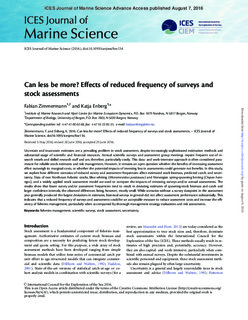Can less be more? Effects of reduced frequency of surveys andstock assessments
Journal article, Peer reviewed
Permanent lenke
http://hdl.handle.net/11250/2399364Utgivelsesdato
2016-08-07Metadata
Vis full innførselSamlinger
- Articles [3012]
- Publikasjoner fra CRIStin [3066]
Sammendrag
Uncertain and inaccurate estimates are a prevailing problem in stock assessment, despite increasingly sophisticated estimation methods and
substantial usage of scientific and financial resources. Annual scientific surveys and assessment group meetings require frequent use of research
vessels and skilled research staff and are, therefore, particularly costly. This data- and work-intensive approach is often considered paramount
for reliable stock estimates and risk management. However, it remains an open question whether the benefits of increasing assessment
effort outweigh its marginal costs, or whether the potential impacts of investing less in assessments could generate net benefits. In this study,
we explore how different scenarios of reduced survey and assessment frequencies affect estimated stock biomass, predicted catch, and uncertainty.
Data of two Northeast Atlantic stocks, blue whiting (Micromesistius poutassou) and Norwegian spring-spawning herring (Clupea harengus),
and a widely applied stock assessment model are used to compare the impacts of removing surveys and/or annual assessments. The
results show that lower survey and/or assessment frequencies tend to result in deviating estimates of spawning-stock biomass and catch and
larger confidence intervals, the observed differences being, however, mostly small. While scenarios without a survey datapoint in the assessment
year generally produced the largest deviations in estimates, biannual surveys in general did not affect assessment performance substantially. This
indicates that a reduced frequency of surveys and assessments could be an acceptable measure to reduce assessment costs and increase the efficiency
of fisheries management, particularly when accompanied by thorough management strategy evaluations and risk assessments.
Beskrivelse
-

